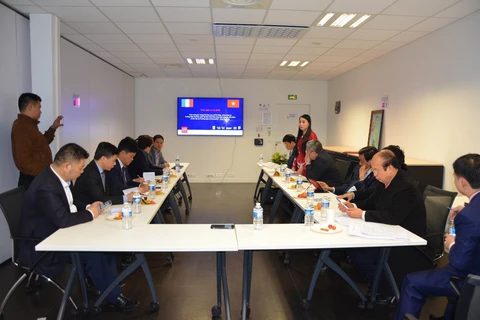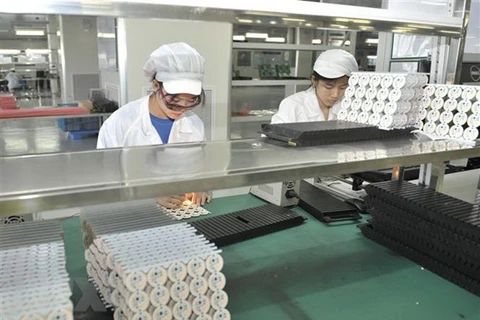Hanoi (VNA) – Though local businesses posted export growths, their contributions to the country’s export value have yet accounted for a half of the contributions of foreign direct investment (FDI) enterprises, according to the Ministry of Industry and Trade.
Speaking highly of the efforts by the community of small and medium-sized enterprises in Hanoi, Deputy Minister of Industry and Trade Dang Hoang An, however, raised a question “when will these enterprises become big or super big companies?”.
He raised the issue at a conference to launch 2019 plan and emulation campaign of the industry and trade sector held by the Hanoi Department of Industry and Trade on January 4.
[2018 hallmarks: export surplus makes a record high, exceeding 7 billion USD]
Stability of products remains low
An presented the picture of the national economy in 2018 when local businesses attained a faster export growth than FDI enterprises, and said the achievement couldn’t hide the fact that local businesses’ contribution to the total export value is yet equal to a half of the sum made by FDI enterprises.
That fact prompted An to raise a question on when the local businesses can make a leap, especially in raising their export value.
He talked about a very few local businesses that have been qualified for supplying components for industrial production plants of foreign investors in Vietnam.
“We can make anything, but it’s difficult to make 1 million products exactly the same,” he said, pointing out that the technology content in products and the capacity of the workforce in the industrial sector remains modest.
He, therefore, asked the Hanoi industry and trade sector to outline solutions to addressing problems still facing it.
To grow sustainably, the sector needs to select key commodities for development and adopt solutions to enabling local businesses to join global value chains, An said.
He reminded businesses of their responsibility as well.
“The Ministry of Industry and Trade, the People’s Committee and the Department of Industry and Trade of Hanoi can give out many orientations, but if businesses are not willing to take in those orientations, it’s hard for all of us to succeed. State agencies could lend only a helping hand to businesses, it’s them to do everything, from organizing production, exporting their products, to looking for consumption markets,” An said.
 Deputy Minister of Industry and Trade Dang Hoang An addresses the conference to initiate tasks of the Hanoi Department of Industry and Trade (Photo: VietnamPlus)
Deputy Minister of Industry and Trade Dang Hoang An addresses the conference to initiate tasks of the Hanoi Department of Industry and Trade (Photo: VietnamPlus) Mac Quoc Anh, Vice Chairman of the Hanoi Small and Medium-sized Enterprises Association said members of the association have worked to increase productivity as well join in integrated value chains since they have been selected to develop key products of the city.
He said the businesses have received support from officials from the municipal Department of Industry and Trade, in specific areas, such as food safety and high technology.
By 2018, over 100 members of the Hanoi Small and Medium-sized Enterprises Association had an effective dialogue channel with the municipal Department of Industry and Trade.
“Through such assistance, businesses boldly proposed the streamlining of administrative procedures and conditions… If their proposals are appropriate, officials of the Department of Industry and Trade will directly address and help seek specific solutions. If the proposals are over the officials’ authority, they will send them to competent agencies of higher levels,” Anh said.
Increasing rivalry pressures in retail sector
According to statistics of the Hanoi Department of Industry and Trade, Hanoi has 22 shopping malls, including 10 first-class malls, one second-class mall, and 11 third-class malls. In addition to that, there are 134 supermarkets and 454 wet markets.
However, the shopping malls are small and medium, located mainly in inner districts, serving retail sale and offices for lease only.
Regarding their competitive capacity, trade businesses in the city are coping with limitations, especially finance capacity, technology, governance and marketing, in comparison with FDI enterprises.
The leaders from the Hanoi Department of Industry and Trade reported that five FDI enterprises owned five shopping malls and 16 supermarkets.
The foreign sector accounted for 22.7 percent of the number of shopping malls and 12 percent of the number of supermarkets, however, when it comes to the market share, they accounted for a lion share, and that share is getting bigger.
Almost big retail names in the world are present in the capital city, such as BigC Thang Long, Mega Market Vietnam, Aeon, Lotte, and Marfour.
The leaders from the Hanoi Department of Industry and Trade commented that by pursuing long-term business strategies, accepting losses, and continuously opening their new retail facilities, foreign retailers have triggered competitive pressures on local goods distributors.
Deputy Minister of Industry and Trade Dang Hoang An said the Hanoi Department of Industry and Trade is working to develop shop models selling safe food, however, many citizens have kept shopping in wet and temporary markets, raising concerns about the management of food safety.
“We can well manage shops but not temporary markets, so we need to do more to raise people’s consumption awareness,” Deputy Minister An added.-VNA


























